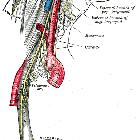glossopharyngeal neuralgia
Glossopharyngeal neuralgia is due to irritation of the glossopharyngeal nerve and presents with repeated episodes of severe pain in the tongue, throat, ear, and tonsils, which can last from a few seconds to a few minutes. It is far less common than trigeminal neuralgia.
Epidemiology
Glossopharyngeal neuralgia is most commonly found in patients older than 50 years of age and is more commonly seen in females .
Clinical presentation
Symptoms include severe pain in areas connected to the ninth cranial nerve:
- tonsil area
- throat
- back of the tongue
- ear
The pain occurs in episodes and may be severe and can sometimes be triggered by chewing, coughing, laughing, speaking or swallowing. Unlike trigeminal neuralgia, a well defined trigger zone is not readily apparent and may never be clearly defined .
In a minority of patients, pain is followed by cardiac symptoms including arrhythmias, asystole, and syncope. In such cases the condition is referred to as vagoglossopharyngeal neuralgia and is believed to be due to complex interconnections between the nervus intermedius, the vagus nerve, and the glossopharyngeal nerve .
Pathology
Glossopharyngeal neuralgia is believed to be caused by irritation of the ninth cranial nerve, although in most cases, the source of irritation is never found. Possible causes include:
- neurovascular compression: blood vessels abutting the nerve root entry zone of the glossopharyngeal nerve
- tumors at the base of the skull
- tumors or infections of the throat and mouth
Radiographic features
The main role of imaging is to identify potential causes at the base of the skull.
CT
CT is unable to visualize the nerve but can delineate the pars nervosa of the jugular foramen.
MRI
MRI is the ideal way to image the nerve which can be seen particularly well on heavily T2 weighted thin section images (e.g. FIESTA/CISS). Contrast is also necessary to assess for abnormal enhancement of the nerve or surrounding structures.
Additionally MRA is required to assess for a compressing vascular loop, most commonly found at the nerve root entry zone.
Treatment and prognosis
The goal of treatment is to control pain. Over-the-counter painkillers such as aspirin and acetaminophen are not very effective for the relief of neuralgia.
The most effective drugs are anti seizure medications, such as carbamazepine, gabapentin, and phenytoin. Some antidepressants, such as amitriptyline, may help certain patients.
In severe cases, when pain is difficult to treat, surgery to decompress the glossopharyngeal nerve may be needed. This surgery is generally considered effective.
If a cause of the neuralgia is found, treatment should be directed towards controlling the underlying problem.
Siehe auch:

 Assoziationen und Differentialdiagnosen zu Glossopharyngeusneuralgie:
Assoziationen und Differentialdiagnosen zu Glossopharyngeusneuralgie:

